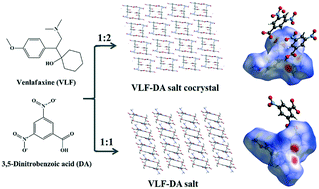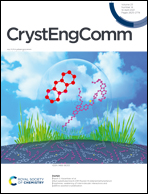Salt or/and cocrystal? The case of the antidepressant drug venlafaxine†
Abstract
Crystallization of venlafaxine (VLF), a widely prescribed antidepressant, in the presence of 3,5-dinitrobenzoic acid (DA; C7H4N2O6) as a coformer led to the formation of a salt in a molar ratio of 1 : 1 and a salt cocrystal in a ratio of 1 : 2. The crystal structures were determined by single-crystal X-ray diffraction. One salt bond and one hydrogen bond form a R22(10) graph set in VLF–DA (1 : 1), and two salt bonds and two hydrogen bonds form an R44(20) graph set plus 2 extra hydrogen bonds in VLF–DA (1 : 2). VLF–DA (1 : 2) is a salt cocrystal, with a VLF–DA (1 : 1) salt in contact with a neutral DA molecule in the asymmetric unit. Both the salt and the salt cocrystal were differentiated from the pure components by powder X-ray diffraction, differential scanning calorimetry, thermogravimetry, Fourier transform infrared spectroscopy, and solid-state nuclear magnetic resonance. Stability measurements revealed that the salt and the salt cocrystal of VLF held superior phase stability against high temperature, high moisture, and illumination. Beyond our expectations, the VLF–DA (1 : 1) salt showed a significantly improved solubility over VLF free base, while the VLF–DA (1 : 2) salt cocrystal held a lower solubility which can be attributed to its crystal arrangements and molecular interactions.

- This article is part of the themed collection: Crystal Growth


 Please wait while we load your content...
Please wait while we load your content...